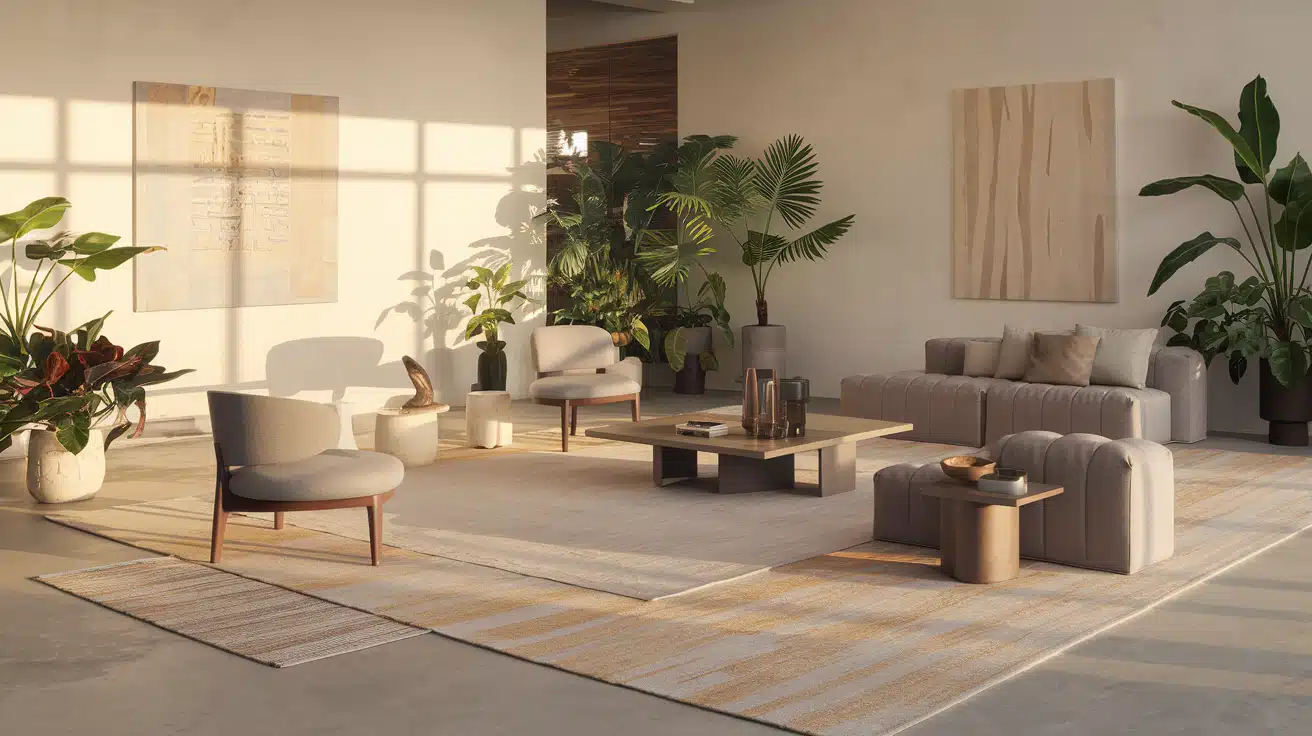Do you scroll through home decor websites and notice how putting one rug on top of another creates a stylish look? This trend is growing fast among interior lovers, and for good reason!
Layering rugs isn’t just pretty—it’s practical too. It brings warmth to your floors while showing off your personal style.
In this guide, you’ll learn what rug layering really means, how it improves your home’s look and feel, and the best ways to combine different rugs.
You’ll learn steps to layer like a pro, get tips for each room in your house, see which mistakes to avoid, and find out how to keep your layered rugs clean and lasting long.
Ready to turn your plain floor into something special? Let’s start with the basics of rug layering!
What is Rug Layering?
Rug layering is simply placing one rug on top of another. It uses a larger base rug with smaller rugs on top. This method combines different sizes, shapes, textures, and patterns to create a unique floor look.
The benefits go beyond just looks:
- More visual interest through mixed patterns and textures
- Extra comfort with multiple padding layers
- Added warmth in cold months
- Easy room updates by changing top layers
- Better space definition in open areas
How Layering Rugs Enhances Your Interior Design
Layered rugs add depth to any room. While a single rug works fine, thoughtfully combined rugs create a more complete look.
Mixing textures (like soft shag over flat weave or natural fiber under patterned wool) creates eye-catching contrast. This blend of materials gives rooms a rich feel that one rug can’t match.
In open floor plans, rug layers help define separate areas without walls. They clearly mark different living zones, making your space feel more organized and purposeful.
Popular Rug Layering Combinations
Creating effective rug layers depends on finding the right pairings. Here are some winning combinations that work well in most homes:
1. Base Rug + Accent Rug Pairings
Finding the right foundation is the first step to successful rug layering. The base and accent rug combination sets the tone for your entire space.
- Natural fiber (jute/sisal) base with a patterned wool or cotton rug on top.
- Solid neutral large rug with a smaller bright patterned rug.
- Large low-pile rug with a smaller high-pile or shag rug for texture contrast.
- Round rug over a square/rectangular base for shape contrast and visual interest.
- Vintage worn rug layered over a solid contemporary base for time-period mixing.
These five pairing options suit every home style. The contrast of natural fibers and patterns adds visual interest, while blending solid neutrals with bright accents infuses personality.
Varying pile heights enhances texture, and combining shapes disrupts visual monotony.
For enthusiasts of old and new, layering vintage pieces over modern bases crafts a rich, collected look that conveys a story.
2. Seasonal Layering Options
Change your room’s look with the seasons by swapping top layers while keeping the same base. This simple switch helps your home feel fresh year-round.
Summer: Light cotton or natural fiber base with thin, bright top layers
Winter: Thick wool base with cozy, warm-toned top layers for extra insulation
3. Style-Specific Combinations
Your personal style shines through in how you combine rugs. Each design approach uses layering differently to create distinct moods and looks.
Modern: Geometric patterns over solid neutrals with clean lines
Bohemian: Mix of bright colors, patterns, and varied textures
Traditional: Classic patterns with subtle color combinations and formal placement
Basic Rules for Successful Rug Layering
To make sure your rug layers look planned rather than messy, follow these basic guidelines:
1. Size Considerations
The base rug should always be significantly larger than the top rug to create proper visual hierarchy in your space.
When placing your top rug, make sure to leave at least 8-12 Inches of the bottom rug visible around all sides to showcase both pieces effectively.
It’s essential that your base rug is properly sized for your room and furniture arrangement to maintain good proportions throughout the space.
2. Pattern Mixing Guidelines
For the Most Pleasing Visual Effect, Pair Simple Designs with Complex Ones, Such as Using a Solid Base with A Patterned Top Rug or The Opposite Approach Depending on Your Preference.
When Working with Multiple Patterns, Try to Mix Different Pattern Scales by Combining Larger Motifs with Smaller, More Detailed Designs for Balanced Contrast.
To Create Cohesion Between Different Patterned Rugs, Find at Least One Common Color that Appears in Both Pieces to Tie Them Together Visually.
3. Color Coordination Tips
Select Rug Colors from The Same Family or Ones that Naturally Complement Each Other to Create a Harmonious Look in Your Layered Arrangement.
Including at Least One Neutral Element Among Your Rug Choices Helps Balance Bold Color Selections and Prevents the Combination from Becoming Overwhelming.
For a Well-Integrated Look, Pull Colors from Existing Room Elements Such as Your Furniture, Wall Color, or Artwork to Connect Your Rug Layers with The Rest of Your Space.
4. Texture Combinations that Work Well
Contrast Smooth Textures with Rough Ones, Such as Pairing a Flat Weave Foundation with A Plush Shag Rug on Top for Interesting Tactile Variation.
Combining Thin Rugs with Thicker Ones, Like Placing a Cotton Flat Weave Over a High-Pile Wool Base, Creates Depth Through Physical Dimension.
Mixing natural fiber rugs with manufactured materials, such as layering jute with synthetic or wool pieces, offers both visual interest and practical benefits in different areas of your home.
Room-by-Room Layering Tips
Different rooms have unique needs when it comes to rug layering. Here’s how to adapt your approach for each space in your home.
1. Living Room Rug Layering
The living room is perfect for statement rug layering since it’s where people gather most. Position your base rug so all furniture front legs rest on it.
For the top layer, try centering a smaller rug under your coffee table.
In larger living rooms, use rug layers to separate sitting areas from reading nooks, creating distinct zones while maintaining a unified look throughout the space.
Quick Tip: The living room is perfect for statement rug layering since it’s where people gather most. Position your base rug so all furniture’s front legs rest on it.
2. Bedroom Rug Layering
In bedrooms, comfort underfoot is key. Place a large base rug that extends 18-24 inches beyond the bed sides. Add a smaller, softer rug at the foot of the bed or on each side where you step out in the morning.
This approach keeps your feet warm while adding visual interest to the room. For extra comfort, consider higher pile rugs for those cold morning wake-ups.
Quick Tip: In bedrooms, comfort underfoot is key. Place a large base rug that extends 18-24 inches beyond the bed sides. Add a smaller, softer rug at the foot of the bed or on each side where you step out in the morning.
3. Dining Room Considerations
Dining rooms need practical rug solutions that accommodate chair movement. Your base rug should extend at least 24 inches beyond the table edge all around.
If layering, keep the top rug smaller than the dining table to avoid interference with chairs. Choose flat, easy-clean materials for both layers since food spills are common.
Consider adding non-slip pads between layers to prevent shifting during chair movements.
Quick Tip: Dining rooms need practical rug solutions that accommodate chair movement. Your base rug should extend at least 24 inches beyond the table edge all around.
4. Entryway and Hallway Approaches
Entryways and hallways see heavy foot traffic and need durable rug combinations. For these high-use areas, select a sturdy, stain-resistant base rug with a washable runner on top.
Make sure edges don’t create tripping hazards in these narrow spaces.
Try positioning runners at slight angles for visual interest, or use multiple small rugs to create a pathway effect through longer hallways while protecting your floors.
Quick Tip: Entryways and hallways see heavy foot traffic and need durable rug combinations. For these high-use areas, select a sturdy, stain-resistant base rug with a washable runner on top.
Common Mistakes to Avoid
When layering rugs, watch out for these common pitfalls that can make your design look unplanned or create practical problems.
- Improper Size Proportions: Using rugs that are too similar in size creates a messy, unintentional look. The base rug should be significantly larger than your top rug. Always ensure there’s at least 8-12 inches of the bottom rug visible around all edges for proper framing.
- Clashing Patterns Without Purpose: Combining competing patterns creates visual confusion. Instead of random mixing, select patterns sharing a color or having complementary styles. Balance busy patterns with simpler designs to provide resting places for the eye.
- Ignoring Practical Needs: Choosing rugs based solely on appearance can lead to regret. High-pile rugs in dining areas trap food, and light colors in entrances reveal dirt quickly. Select materials suitable for each room’s use and traffic patterns.
- Overcrowding The Space: Adding too many rugs or layers makes a room feel cluttered rather than styled. Limit yourself to 2-3 layers maximum. Give each layer room to shine instead of cramming multiple small rugs into the same area.
Wrapping Up Your Rug Layering Trek
Layering rugs offers a simple yet effective way to transform your living spaces. We’ve walked through the basics, explored winning combinations, and shared tips for each room in your home.
Remember to keep your base rug larger than your top layer, mix patterns thoughtfully, and choose materials suited to each room’s needs. Avoid common errors like creating trip hazards or overcrowding your space.
The beauty of rug layering lies in its flexibility—you can completely change your room’s mood by swapping just the top layer.
We hope this guide inspires you to try this technique in your own home. Start with one room, experiment with different combinations, and watch how this simple change adds character and comfort to your spaces.
What room will you transform first?








